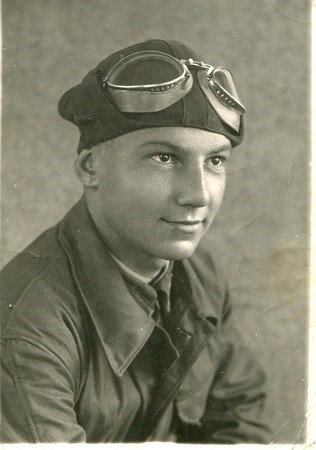Leonid Rappoport was born in 1922 in Chernigov, Ukraine. After graduating from school in 1939, he moved to Moscow. In June 1940 he was drafted into the Red Army and sent to a school for military pilots in Gostomel, a town close to Kiev. Following the German attack on the Soviet Union, the Gostomel school was evacuated to the town of Engels (in Russia on the Volga). Rappoport graduated from the flight school in Engels in December 1941 with the rank of sergeant and in 1942 was assigned as a pilot to the 639th Attack Aircraft Regiment. The regiment operated in western Russia. From July 5, 1942 its main mission was to attack Seshcha – the site of one of the oldest and largest Soviet military airfields, that had been captured by the Germans in 1941.
Sergeant Rappoport's active service continued for a relatively short time, from July to September 1942. The handsome young pilot proved to be a brave and skillful flier, beloved by the rest of the regiment. On his first day of active combat, July 5, 1942, Rappoport rescued his commander's plane, when it was attacked by a German Messerschmidt-109. Rappoport attacked the Messerschmidt and shot it down. For this Rappoport was recommended for the Order of the Red Banner. Inter alia, the citation said "Deeply understanding Order № 227 of Comrade Stalin [the order known as 'Not one step backward!'], he leaves for combat missions with raised spirits and joy. Neither enemy anti-aircraft fire nor enemy fighters are able to stop him and to prevent him from carrying out his mission." With 17 successful sorties between July and September 1942 Rappoport was regarded as the most effective military flier of the regiment. The slogan "Strike the despised enemy the way that Rappoport does!" was written on the wall of one of the regiment's buildings.
On August 23, Rappoport took off on a bombing sortie but when he was close to the target, his fuel tank was hit by an enemy bullet and caught fire. Nevertheless, the pilot decided to complete his bombing [mission]. With his fuel tank burning, he attempted to return but was attacked by enemy fighters. A shell hit the plane's radiator and a jet of boiling water struck the pilot in the face. Another shell set fire to the engine. The next moment Rappoport was wounded in his face by a shell fragment: his face, from the left eye to mouth, was permanently mutilated. Despite all this, the valiant pilot succeeded in landing his plane at his airfield.
After a short stay in a military hospital, Rappoport returned to active service. On September 13, 1942, a squad of attack planes, including his, set out to bomb Seshcha. For Rappoport, this was his first sortie after his release from the hospital. Due to a mistake made by the commanding officer of the squad, the group failed to carry out its mission and the Germans succeeded in repelling the attack. Of the eight planes of that had set forth on their mission, six did not return. Among the latter was Rappoport's aircraft. On that day, he was not yet 20 years old. He was awarded the Order of the Red Banner, posthumously, four days after he perished.
From a report on inter-ethnic Relations in the 639th Attack Aircraft Regiment
"On the measures for improvement and the work done among non-Russian servicemen"
"There are a total of 105 servicemen in the regiment (sic!).
Their ethnic breakdown is: Russians – 76; Ukrainians – 18; Belorussians – 2; Jews – 6; Georgians – 2; Mordovians – 1.
Despite the multi-ethnic composition of the regiment, there is no ethnic antagonism, and no abnormal or hostile relations on a national [i.e., ethnic] basis have been noted. All the personnel form one friendly family… An example of this friendship is the love and respect of all the personnel for the pilot Senior Lieutenant Kardava, a Georgian by nationality. The whole flight- and technical staff was grieved by his failure to return from a mission. There is the same attitude toward the young pilot Rappoport, a Jew by nationality, who has made 16 attack sorties and was wounded twice, and who showed fearlessness and skill in combat, for which the command of the regiment recommended him for a state award..."
[The document is cited from the website "Remember the War"]







